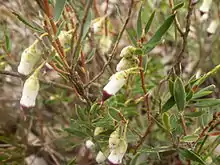Conostephium
Conostephium is a genus of flowering plants in the family Ericaceae. The name of the genus comes from Greek words, conos, "cone" and stephanos, "that which encircles, a crown or wreath".[1]
| Conostephium | |
|---|---|
 | |
| Pearl flower Conostephium pendulum | |
| Scientific classification | |
| Kingdom: | Plantae |
| Clade: | Tracheophytes |
| Clade: | Angiosperms |
| Clade: | Eudicots |
| Clade: | Asterids |
| Order: | Ericales |
| Family: | Ericaceae |
| Subfamily: | Styphelioideae |
| Tribe: | Styphelieae |
| Genus: | Conostephium Benth |
| Type species | |
| Conostephium pendulum | |
Description
The plants in the genus Conostephium are small evergreen shrubs with small to medium-sized simple leaves. The flowers occur singly in the axils of the leaves, have 5 sepals, 5 corolla lobes ("petals") which are united at their base into a long corolla tube, and 5 stamens. The fruit is a more or less fleshy drupe.[2]
Taxonomy
There are 12 species in the genus, 4 having been added recently. The most distinctive features of the genus are the corolla tube which is conical in the upper half, the tiny corolla lobes and very long anthers which are fully enclosed within the corolla tube. These 3 features are thought to be adaptations to buzz pollination.[3][4] The genus is most closely related to Brachyloma and Stenanthera but those genera have saccate corolla tubes, much large corolla lobes and shorter anthers which extend partially beyond the corolla tube.[5]
Conostephium pendulum was the first species of Conostephium to be described (by Bentham in 1837). Then, within ten years, two more were added - (C. minus and C. preissii). In 1859, the Russian botanist Sergej Sergeevitch Stscheglejew described a new genus, Conostephiopsis in which he placed a new species (Conostephiopsis drummondii). At the same time, he transferred C. minus and C. preissii to the new genus, making Conostephium once more monotypic. In 1886, Bentham in Flora Australiensis grouped the two genera and added a fourth species (Conostephium roei). Much later, C. marchantiorum Strid (1986), C. uncinatum Moezel (1987) and C. magnum Cranfield (2002) were added. The latest additions were made (in 2013) by Michael Hislop, a botanical taxonomist at the Western Australian Herbarium[6]
Species
The following is a list of Conostephium species accepted by the Australian Plant Census as at September 2020:
- Conostephium drummondii Stschegl C.A.Gardner
- Conostephium hortiorum Hislop
- Conostephium laeve Hislop
- Conostephium magnum Cranfield
- Conostephium marchantiorum Strid
- Conostephium minus Lindl
- Conostephium papillosum Hislop
- Conostephium pendulum Benth
- Conostephium preissii Sond
- Conostephium prolatum Hislop
- Conostephium roei Benth
- Conostephium uncinatum Moezel
Distribution
All Conospermum species are endemic to the southwestern part of Western Australia.[7]
References
- "Conostephium pendulum". Friends of Queens Park bushland. 2011. Retrieved 18 January 2015.
- Coleman, H.R. (3 October 2008). "Florabase - The Western Australian Flora". Retrieved 10 January 2015.
- Johnson, Karen A.; MacQuillan, Peter B. (2011). "Comparative floral presentation and bee-pollination in two Sprengelia species (Ericaceae)". Cunninghamia. 12 (1): 45.
- Houston, Terry F.; Ladd, P.G. (7 February 2002). "Buzz pollination in the Epacridaceae". Australian Journal of Botany. 50 (1): 83–91. doi:10.1071/BT01020.
- Hislop, Michael (25 July 2013). "A taxonomic update of Conostephium (Ericaceae: Styphelioideae: Styphelieae)". Nuytsia. 23: 313–335.
- Cowley, K.J.; West, J.G. (July 2013). "Resources of Australian Herbaria". Council of Heads of Australasian Herbaria (CHAH). Retrieved 18 January 2015.
- Paczkowska, Grazyna; Chapman, Alex R. (2000). The Western Australian flora : a descriptive catalogue. Perth: Wildflower Society of Western Australia. pp. 235, 236. ISBN 0646401009.